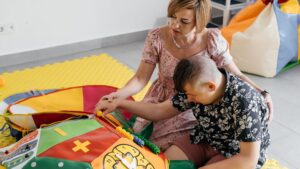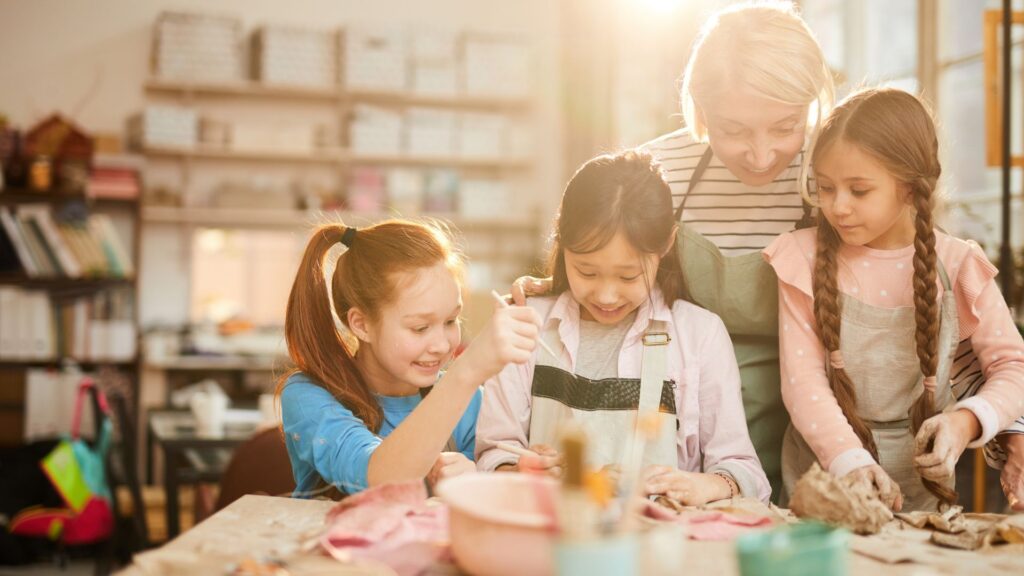In the realm of special needs care, traditional approaches often focus solely on medical interventions and behavioral therapies. However, there exists a profound avenue for healing that transcends the clinical realm and taps into the depths of human expression: creativity. In this blog, we explore the transformative power of art in therapy for special needs children. Titled “Healing Through Creativity: The Intersection of Art and Therapy for Special Needs Children,” our journey delves into the intersection where artistic expression meets therapeutic intervention, offering hope and healing to those navigating the challenges of developmental disabilities. Through various forms of creative expression such as painting, music, dance, and storytelling, we uncover the profound impact these mediums have on cognitive, emotional, and social development. Join us as we unveil the beauty and efficacy of harnessing creativity as a tool for empowerment and growth in the lives of special needs children.
Crafting Connections: How Art Facilitates Social Interaction in Special Needs Communities

In the realm of special needs communities, fostering social interaction and building meaningful connections can be both a challenge and a vital aspect of holistic development. Traditional approaches to socialization may not always suit the diverse needs of individuals with disabilities. However, through the medium of art, a transformative avenue emerges, offering unique opportunities for connection and communication. In this exploration, we delve into the ways in which art facilitates social interaction within special needs communities, enriching lives and nurturing relationships.
Art as a Universal Language
Art transcends linguistic and cultural barriers, offering a universal language through which individuals can communicate and connect. This universal quality of art holds particular significance in special needs communities, where traditional modes of communication may present obstacles. Through painting, drawing, sculpting, and other creative activities, individuals with diverse abilities can express themselves authentically, forging connections based on shared experiences and emotions rather than verbal dialogue alone.
Creating Inclusive Spaces
Artistic endeavors provide inclusive spaces where individuals of all abilities can participate and contribute according to their unique strengths and preferences. Inclusive art programs invite collaboration, encouraging participants to work together towards a common creative goal. Whether it’s a collaborative mural project or a group sculpture workshop, these shared experiences foster a sense of belonging and camaraderie within the community, breaking down barriers and promoting empathy and understanding.
Developing Social Skills
Art activities offer valuable opportunities for developing essential social skills such as cooperation, turn-taking, and empathy. Within the context of a supportive art environment, individuals with special needs can practice these skills in a low-pressure setting, building confidence and self-esteem as they engage in meaningful interactions with peers and mentors. Through collaborative art projects, participants learn to communicate effectively, negotiate differences, and appreciate the diverse perspectives of their fellow creators.
Celebrating Diversity
Art celebrates the diversity of human experience, honoring individuality and encouraging self-expression. In special needs communities, this celebration of diversity takes on added significance, affirming the unique talents and contributions of each individual. Artistic exploration allows individuals to express their identities authentically, fostering a sense of pride and self-acceptance. By showcasing the rich tapestry of talents within the community, art promotes inclusivity and challenges stereotypes, fostering a culture of acceptance and appreciation.
Building Bridges Beyond the Community
Art has the power to bridge divides, connecting special needs communities with the broader society. Through exhibitions, performances, and public art installations, individuals with disabilities can share their creations with the world, promoting awareness and understanding. These outreach efforts not only showcase the talents of special needs artists but also challenge perceptions and promote dialogue, fostering greater inclusivity and accessibility in the wider community.
Sculpting Resilience: Building Coping Skills Through Creative Expression

In the face of life’s challenges, cultivating resilience is essential for maintaining mental and emotional well-being. Creative expression, particularly through art, offers a unique pathway for individuals to develop coping skills and strengthen their resilience. Through sculpting, painting, and other artistic endeavors, individuals can navigate adversity, build emotional strength, and emerge stronger than before.
- Outlet for Emotions: Art provides a safe and constructive outlet for processing difficult emotions such as stress, anxiety, and grief. Through creative expression, individuals can externalize their feelings, gaining clarity and perspective on their experiences.
- Cathartic Release: Engaging in artistic activities can be cathartic, allowing individuals to release pent-up emotions and tension. Sculpting, in particular, offers a tactile means of expression, enabling individuals to physically mold and shape their emotions into tangible forms.
- Empowerment Through Creativity: Artistic expression empowers individuals to reclaim a sense of agency in their lives. By engaging in creative activities, individuals assert control over their narratives, transforming adversity into opportunities for growth and self-discovery.
- Building Resilience: Through the process of creating art, individuals develop resilience by learning to embrace challenges and persevere in the face of setbacks. Artistic endeavors teach valuable lessons in patience, perseverance, and adaptability, equipping individuals with the tools they need to navigate life’s ups and downs.
Creative expression serves as a powerful tool for building resilience and coping skills in the face of adversity.
The Canvas of Possibilities: Art as a Therapeutic Tool for Sensory Processing Disorders

Sensory processing disorders (SPD) pose unique challenges for individuals, impacting their ability to effectively interpret and respond to sensory stimuli. From hypersensitivity to certain textures or sounds to difficulties with sensory modulation, these disorders can significantly affect daily functioning and quality of life. In recent years, the field of art therapy has emerged as a promising avenue for addressing the sensory needs of individuals with SPD. In this exploration, we delve into the ways in which art serves as a therapeutic tool for sensory processing disorders, offering a canvas of possibilities for self-expression, exploration, and regulation.
Sensory Exploration through Art
Art provides a safe and supportive environment for sensory exploration, allowing individuals with SPD to engage with different textures, colors, and materials at their own pace. Through painting, drawing, sculpting, and other artistic activities, individuals can experiment with sensory inputs, gradually desensitizing themselves to aversive stimuli and developing greater tolerance and flexibility. Artistic exploration encourages individuals to embrace their sensory experiences, fostering a sense of empowerment and control over their environment.
Regulating Sensory Responses
Art therapy offers a unique platform for sensory regulation, helping individuals with SPD to manage overwhelming sensory experiences and achieve a state of calm and relaxation. Engaging in creative activities can serve as a form of sensory integration, helping individuals to organize and make sense of incoming sensory information. By focusing their attention on the creative process, individuals can redirect their sensory responses, shifting from a state of dysregulation to one of equilibrium and stability.
Expressive Outlets for Emotional Processing
Art serves as a powerful tool for emotional expression and processing, allowing individuals with SPD to communicate complex feelings and experiences that may be difficult to verbalize. Through artistic expression, individuals can externalize internal sensations, emotions, and memories, gaining insight into their own thoughts and feelings. Art therapy provides a nonverbal means of communication, enabling individuals to express themselves authentically and connect with others on a deeper level.
Promoting Self-Discovery and Identity Formation
Artistic exploration encourages individuals with SPD to explore and celebrate their unique sensory preferences and experiences, fostering a sense of self-discovery and identity formation. Through the creative process, individuals can discover new ways of engaging with the world around them, embracing their sensory differences as integral aspects of their identity. Art therapy empowers individuals to embrace their strengths and talents, cultivating a sense of pride and self-confidence in their abilities.
Building Social Connections
Art therapy offers opportunities for individuals with SPD to connect with others who share similar sensory experiences and challenges. Group art activities provide a supportive community where individuals can learn from one another, share insights and strategies, and celebrate their successes together. Through collaborative art projects, individuals develop social skills such as cooperation, communication, and empathy, fostering a sense of belonging and camaraderie within the group.
Conclusion
At AWC Behavioral Health LLC in Boca Raton, we firmly believe in the transformative power of creativity in the healing journey of special needs children. Through our innovative approach, integrating art and therapy, we have witnessed remarkable progress and positive outcomes in our young clients. By providing a nurturing environment that fosters self-expression and emotional exploration, we are dedicated to unlocking the potential within each child, empowering them to navigate life’s challenges with resilience and confidence. Together, we continue to champion the profound intersection of art and therapy as a beacon of hope and healing for all.

